Top 10 Best Productivity Apps for Students in 2025
Discover the best productivity apps for students to boost your grades and stay organized. Find out which apps can help you succeed in 2025!
Oct 19, 2025

Juggling lectures, assignments, and a social life can feel like a marathon with no finish line. The secret to staying ahead isn't just working harder-it's working smarter. The right digital tools can transform chaotic study sessions into streamlined, effective workflows, helping you reclaim your time and reduce stress. We've gone beyond the usual recommendations to find the 12 best productivity apps for students that genuinely make a difference. From capturing lecture notes without typing a single word to managing complex group projects, this list is your ultimate toolkit for academic success.
This guide is designed to be a straightforward resource. We'll dive into what makes each app stand out, who it's best for, and its key features-complete with screenshots and direct links to get you started immediately. Whether you need a powerful note-taker like MurmurType, a robust project manager like Trello, or a simple tool to keep you focused, you'll find a solution here. For comprehensive organization and task management, a digital planner can also be an indispensable tool for students, integrating perfectly with many of the apps we cover. Let's find the perfect tools to supercharge your study habits.
1. MurmurType
MurmurType stands out as a premier speech-to-text application for Mac users, solidifying its place as one of the best productivity apps for students. It excels at converting spoken words into text with incredible accuracy, making it perfect for transcribing lectures, brainstorming essays, or dictating research notes directly into any application.
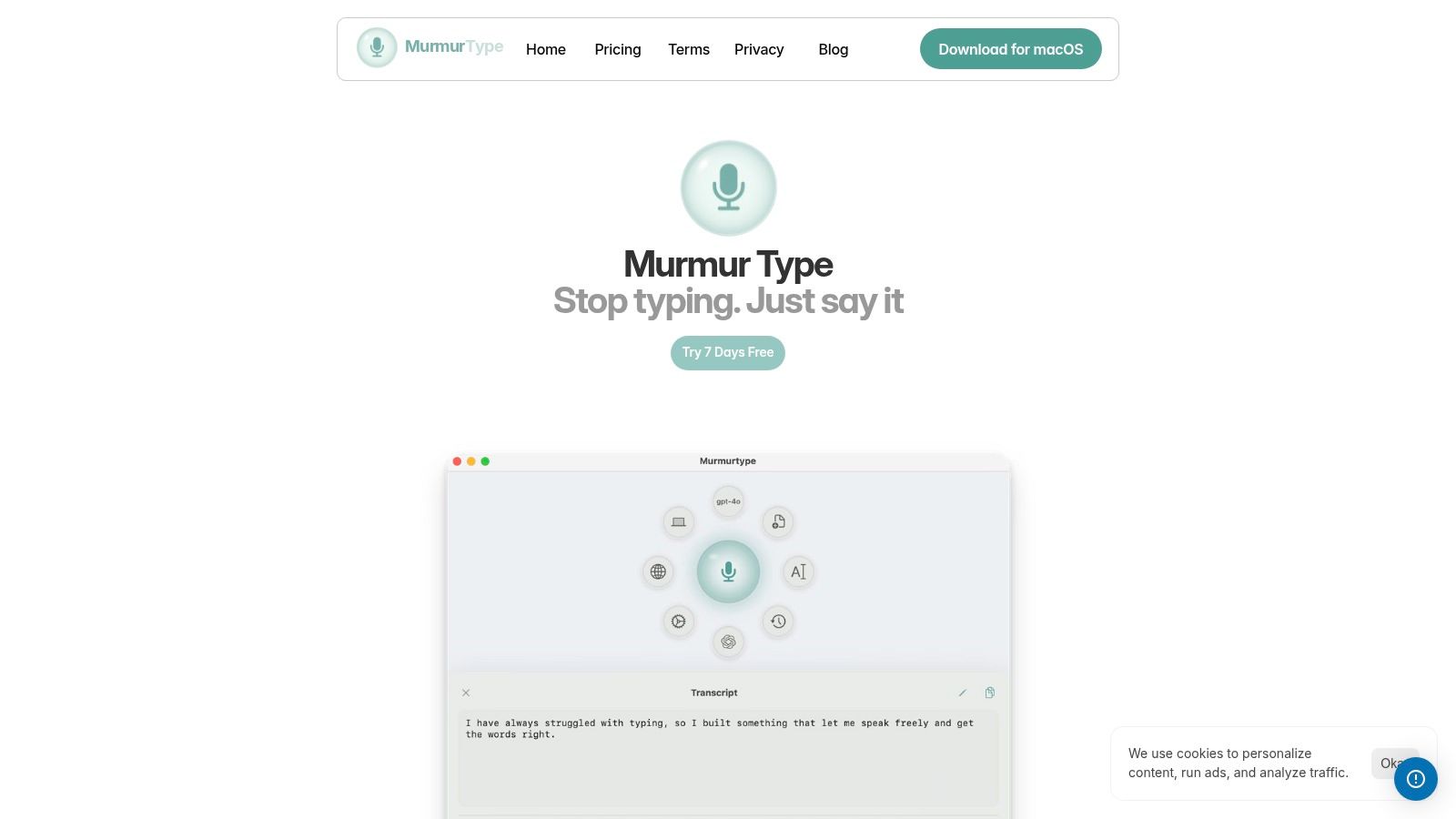
What truly sets MurmurType apart is its dedication to user privacy and flexibility. You can choose a fully local transcription mode, which processes all your audio on your device, ensuring sensitive research or personal thoughts remain completely private. For those who prefer the power of the cloud without technical hassle, its managed service offers top-tier accuracy without requiring you to manage API keys.
This seamless integration into the Mac ecosystem means you can dictate into your email, a Google Doc, or even your coding IDE without skipping a beat. The app is praised for its ability to understand complex academic language and even whispered speech, a feature that’s invaluable during late-night study sessions in the library. While it's a powerful tool on its own, you can learn more about how it complements other lecture recording apps on MurmurType.me.
Key Features and Pricing
MurmurType offers a robust feature set tailored for academic and professional use.
Transcription Modes: Choose from Local (100% private), OpenAI-connected, or a managed cloud service.
High Accuracy: Excels at capturing complex terminology, accents, and quiet speech.
System-Wide Integration: Works flawlessly across all Mac applications.
Flexible Pricing: A one-time purchase is available for $70, alongside affordable monthly ($6.99) and annual ($20) plans. It also includes a 7-day free trial.
Pros:
Unmatched accuracy praised by academics and creators.
Multiple privacy modes, including a secure local-only option.
Flexible, student-friendly pricing with a one-time purchase option.
Seamless integration enhances workflow across all apps.
Cons:
The local mode requires downloading large language models.
Cloud transcription has time limits that may require top-ups for heavy users.
2. Apple App Store
For students in the Apple ecosystem, the App Store isn't just a marketplace; it's a highly curated launchpad for finding the best productivity apps for students. Instead of navigating the open web, you get a secure, streamlined environment where every app has been vetted for quality and safety. This curated approach is its greatest strength, with Apple Editors often creating collections specifically for education, like "Apps for College" or "Study Starters."
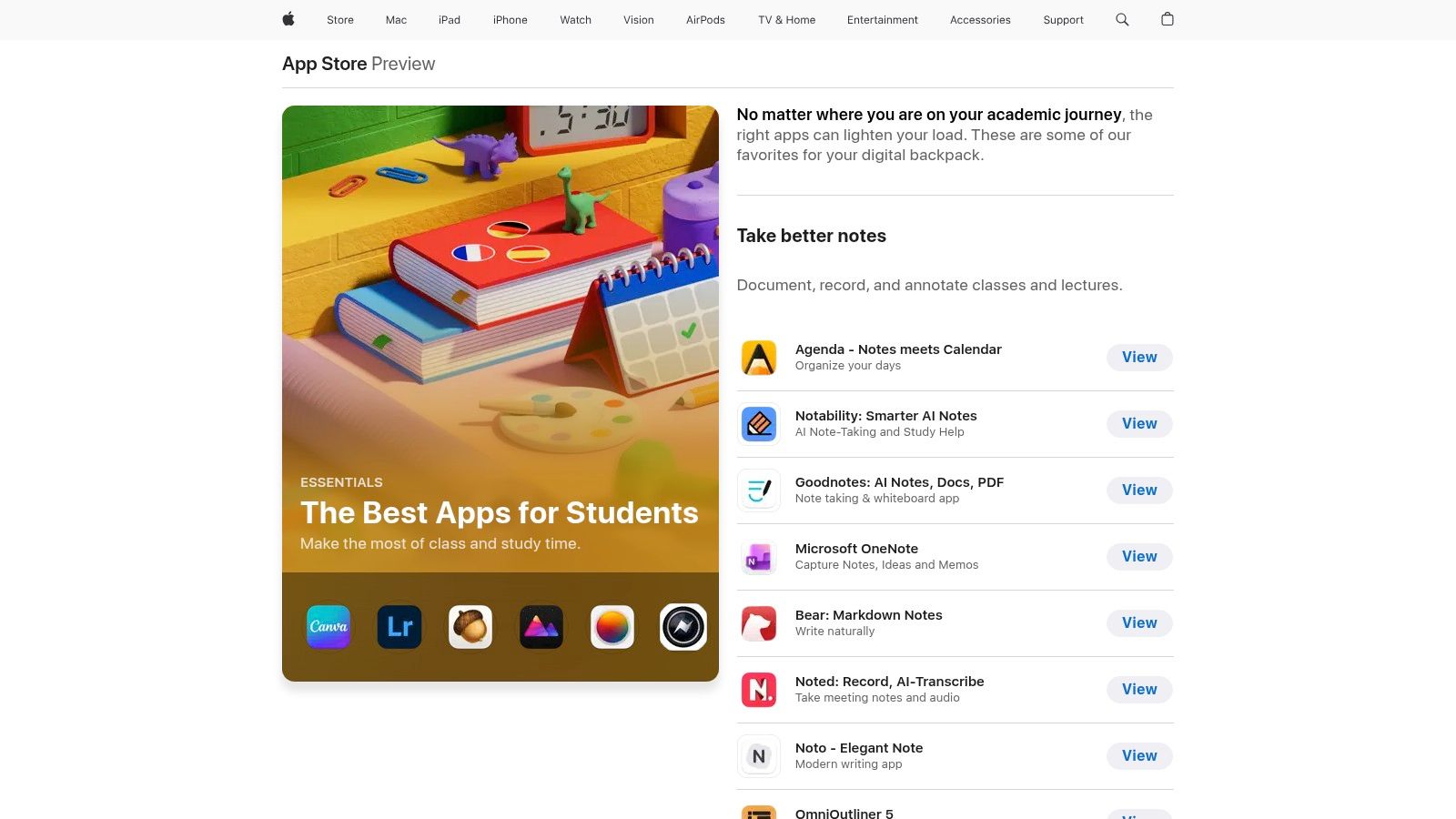
The user experience is seamless, with clear screenshots, user reviews, and upfront details on in-app purchases. Managing subscriptions or requesting refunds is incredibly simple through your Apple ID, taking the headache out of trying new tools.
Why It’s a Go-To Resource
The App Store excels by providing a high-trust environment. You know the apps are optimized for your iPhone or iPad and have passed Apple's strict review process. This eliminates the risk of downloading faulty or malicious software.
Pros: High safety standards, easy subscription management, and editor-curated lists for students.
Cons: Exclusive to iOS/iPadOS, and the cost of multiple paid apps or subscriptions can add up quickly.
Pro Tip: Use the "Family Sharing" feature to share purchased apps with up to five family members, which can significantly cut down on costs for essential student tools.
Website: Apple App Store Education Collection
3. Google Play
For Android users, Google Play is the definitive gateway to discovering the best productivity apps for students. More than just an app market, its editorial collections handpick top-tier tools for focus, task management, and collaboration. These curated lists are a lifesaver, helping students cut through the noise and assemble an effective digital study toolkit without endless searching.
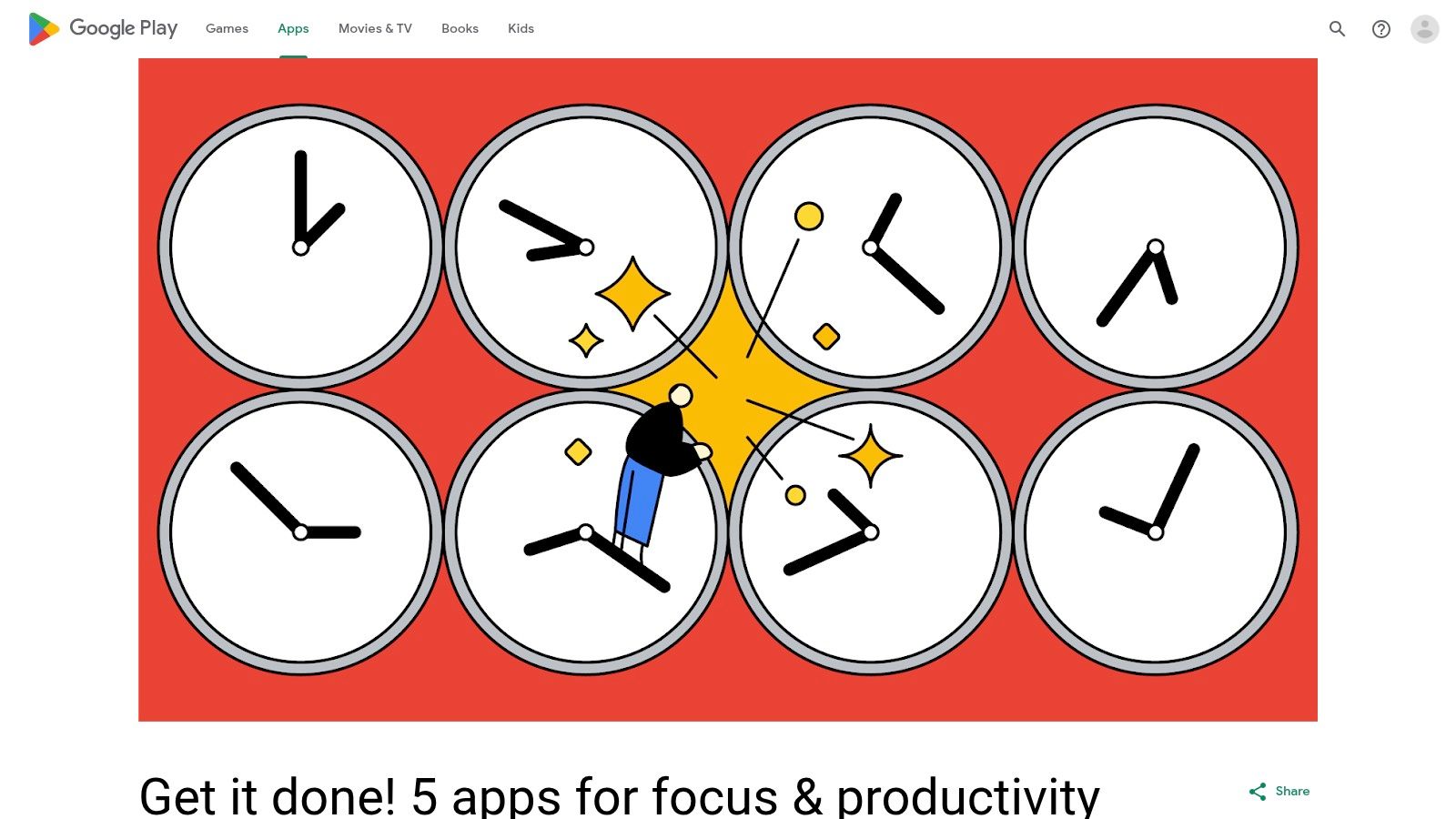
The user experience is straightforward, with clear ratings, permission transparency, and device compatibility filters. This ensures you know exactly what you're downloading and whether it will work seamlessly across your phone, tablet, or Chromebook.
Why It’s a Go-To Resource
Google Play’s strength lies in its massive selection and cross-device functionality. Editor-recommended apps often come with concise use cases, giving you a quick idea of how a tool can fit into your study routine. The frequent discounts and promotions also make premium apps more accessible on a student budget.
Pros: Huge selection with frequent discounts, and works across Android phones, Chromebooks, and tablets.
Cons: App quality varies; users need to vet developers carefully, and regional app listings may differ by locale.
Pro Tip: Use the Google Play Pass subscription for access to hundreds of paid apps and games without ads or in-app purchases, which can be a cost-effective way to try premium study tools.
Website: Google Play Productivity Collection
4. Microsoft 365
For decades, Microsoft 365 (formerly Office 365) has been the cornerstone of academic productivity. It’s more than just a collection of apps; it's a comprehensive ecosystem that includes Word, Excel, PowerPoint, and OneNote. This suite offers a familiar, powerful environment for everything from writing essays to creating complex data presentations, making it one of the best productivity apps for students. The integration of 1 TB of OneDrive storage ensures all your work is backed up and accessible from any device.
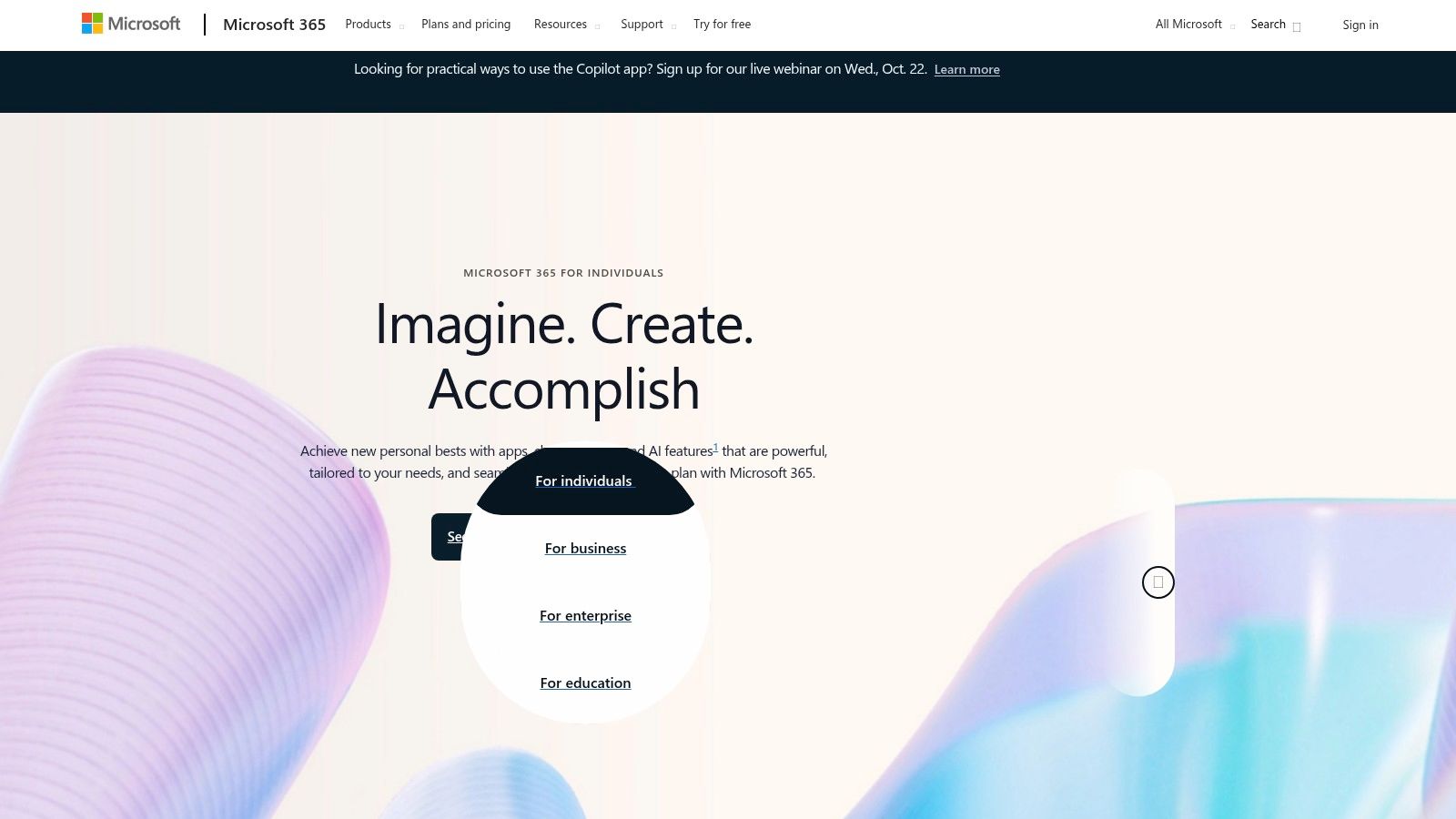
The user experience is unified across desktop and mobile, with robust offline capabilities that competitors often lack. The addition of the AI-powered Copilot helps you draft content, summarize lecture notes, and generate presentation slides faster, which can dramatically increase work efficiency. Many educational institutions offer Microsoft 365 for free, making it an accessible and essential tool.
Why It’s a Go-To Resource
Microsoft 365’s strength lies in its universal compatibility and deep feature set. Nearly every professor and employer uses its file formats, eliminating conversion headaches. The seamless sync between the powerful desktop apps and their mobile counterparts ensures your productivity never misses a beat.
Pros: Ubiquitous file format compatibility for school work, strong offline functionality with seamless cloud sync, and often free through educational institutions.
Cons: Subscription costs after promotional periods or graduation can be high, and the most advanced AI features may require a premium subscription.
Pro Tip: Use OneNote's "Send to OneNote" feature from your browser or Outlook to quickly save research articles, emails, and web clippings directly into your class notebooks for easy organization.
Website: Microsoft 365
5. Notion
Notion is a versatile, all-in-one workspace that lets students build a system perfectly tailored to their needs. It combines notes, tasks, wikis, and databases into a single, highly customizable platform, making it one of the best productivity apps for students who want to create a central hub for their entire academic life. Students can build everything from a simple to-do list to a comprehensive semester dashboard that tracks assignments, syllabi, and study notes.
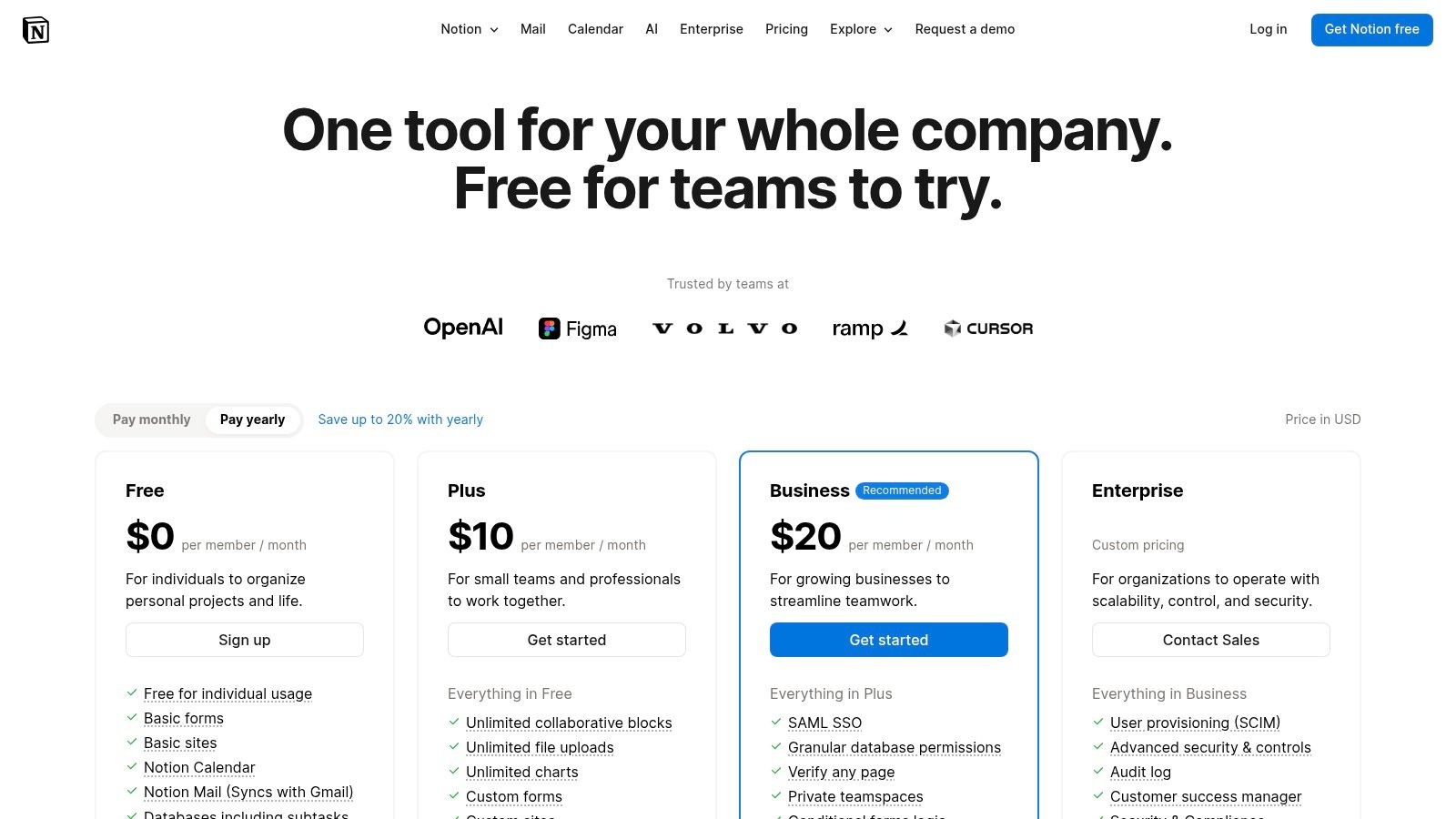
Its strength lies in its flexibility. You can use community-made templates for class schedules or project management, or start from a blank page to design your ideal workflow. Eligible students can also get the Plus plan for free, unlocking more advanced features without any cost.
Why It’s a Go-To Resource
Notion stands out because it adapts to you, not the other way around. Instead of juggling multiple apps for notes, calendars, and tasks, you can consolidate everything into one interconnected system. This consolidation is a game-changer for organizing complex research projects or managing a heavy course load.
Pros: Highly customizable for individual workflows, strong community with many shared templates, and free access to the Plus plan for students.
Cons: Has a notable learning curve, especially with databases, and some advanced AI features require higher-tier paid plans.
Pro Tip: Start by exploring the official template gallery or searching YouTube for student dashboards. Importing a pre-built template is the fastest way to learn the ropes and get organized quickly.
Website: Notion Pricing
6. Todoist
Todoist is a masterclass in task management, making it one of the best productivity apps for students looking to conquer their academic workload. Its clean, minimalist interface allows you to quickly capture and organize every assignment, deadline, and study session. The app’s natural language input is a standout feature; simply type "Submit history essay next Friday at 5 pm," and Todoist automatically schedules it with a reminder.
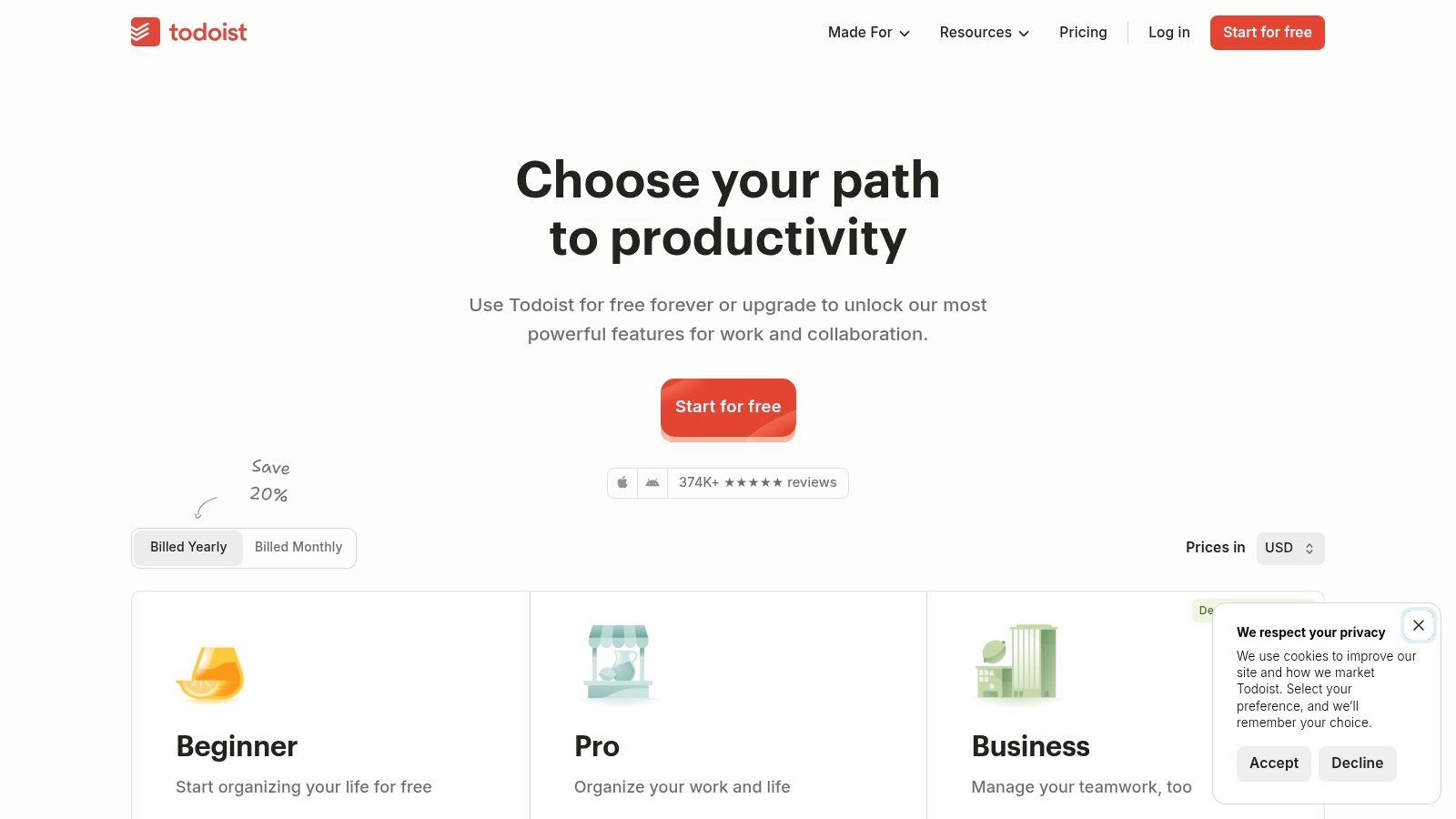
The user experience is incredibly intuitive across all devices, from web to mobile. You can view tasks in lists, boards, or a calendar, adapting the layout to match your workflow for different subjects or projects. This flexibility makes it easy to get a high-level overview of your week or drill down into specific course requirements.
Why It’s a Go-To Resource
Todoist shines because of its speed and simplicity combined with powerful organizational capabilities. It gets out of your way so you can focus on adding tasks, not figuring out complex software. For students juggling multiple classes, extracurriculars, and personal commitments, the robust filtering and labeling system helps create a clear, actionable plan for each day.
Pros: Fast and intuitive interface usable across platforms, robust filtering and labeling for complex course loads.
Cons: Attachments and advanced filters are limited to paid plans, and the free plan has project and feature limits.
Pro Tip: Use the browser extension to quickly add websites as tasks, perfect for saving research articles or online resources to read later.
Website: Todoist
7. Trello
For students juggling group projects or managing multi-step assignments, Trello offers a visual and intuitive way to stay organized. It operates on a Kanban board system, allowing you to move tasks represented as "cards" through different stages like "To-Do," "In Progress," and "Done." This makes it one of the best productivity apps for students who thrive on visual progress trackers and need a clear overview of their entire workflow.
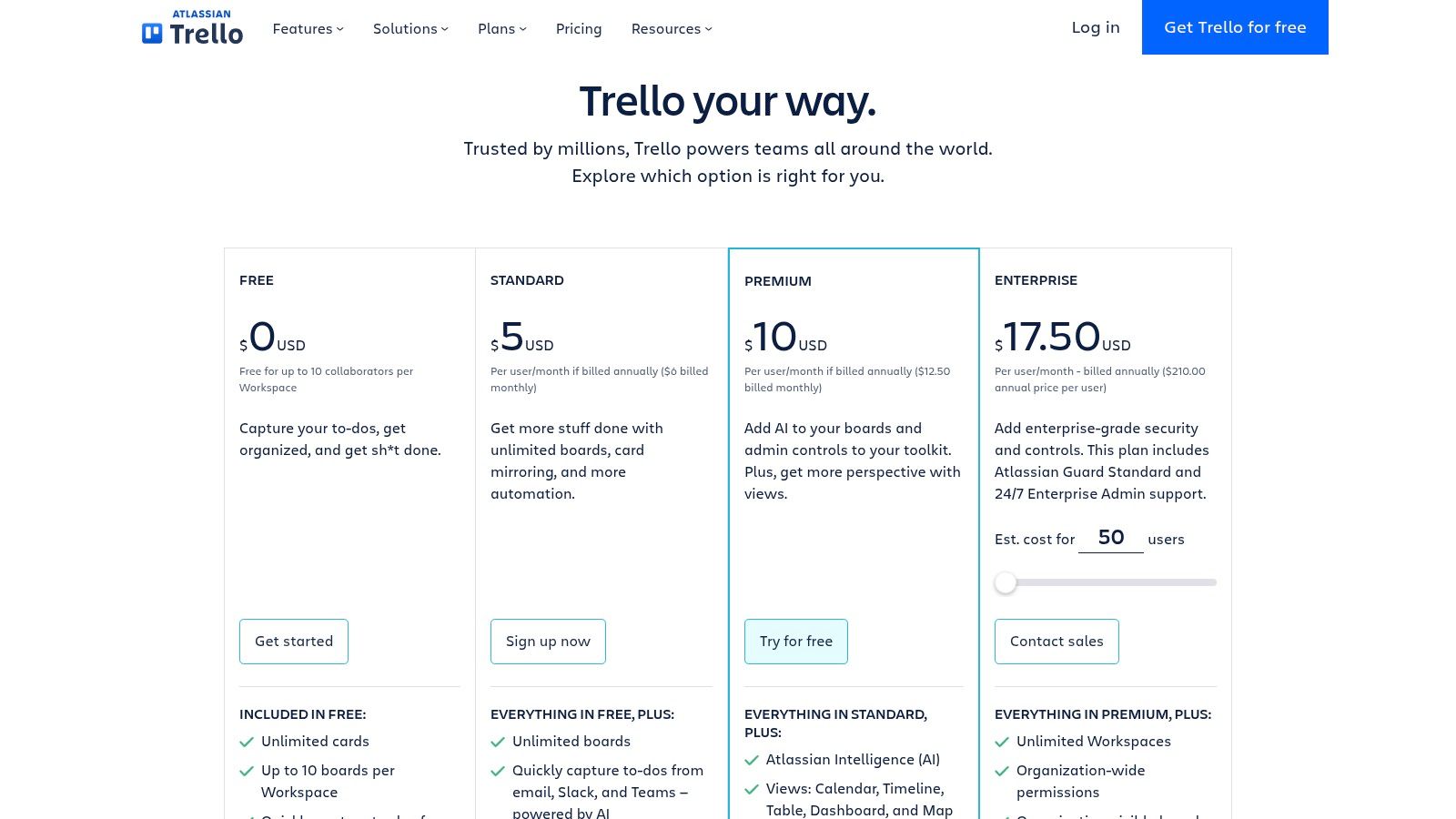
The user experience is incredibly straightforward, making collaboration seamless. You can add checklists, assign due dates, attach files, and comment directly on cards, keeping all project-related communication in one place. The free plan is robust enough for most individual and small-group academic needs.
Why It’s a Go-To Resource
Trello excels at making complex projects manageable by breaking them down into visible, bite-sized tasks. Its flexibility allows you to customize boards for anything from planning a research paper to coordinating a club event. The integration with "Power-Ups" lets you connect Trello to other apps like Google Drive or Slack, creating a centralized command center for your studies.
Pros: Highly visual and easy to learn, free tier is very generous, and it's excellent for team collaboration.
Cons: Can become cluttered if boards aren't managed carefully, and advanced features like timeline or calendar views require a paid subscription.
Pro Tip: Create template cards for recurring tasks, like weekly readings or assignment checklists. This saves you setup time for each new course or project.
Website: Trello
8. Asana
For students tackling complex group projects, senior theses, or capstone assignments, Asana is a significant step up from a simple to-do list. It’s a powerful project management platform that organizes every task, deadline, and team member in a shared workspace. Its strength lies in visualizing work through multiple views like lists, Kanban boards, calendars, and Gantt-style timelines, making it one of the best productivity apps for students managing multifaceted projects.
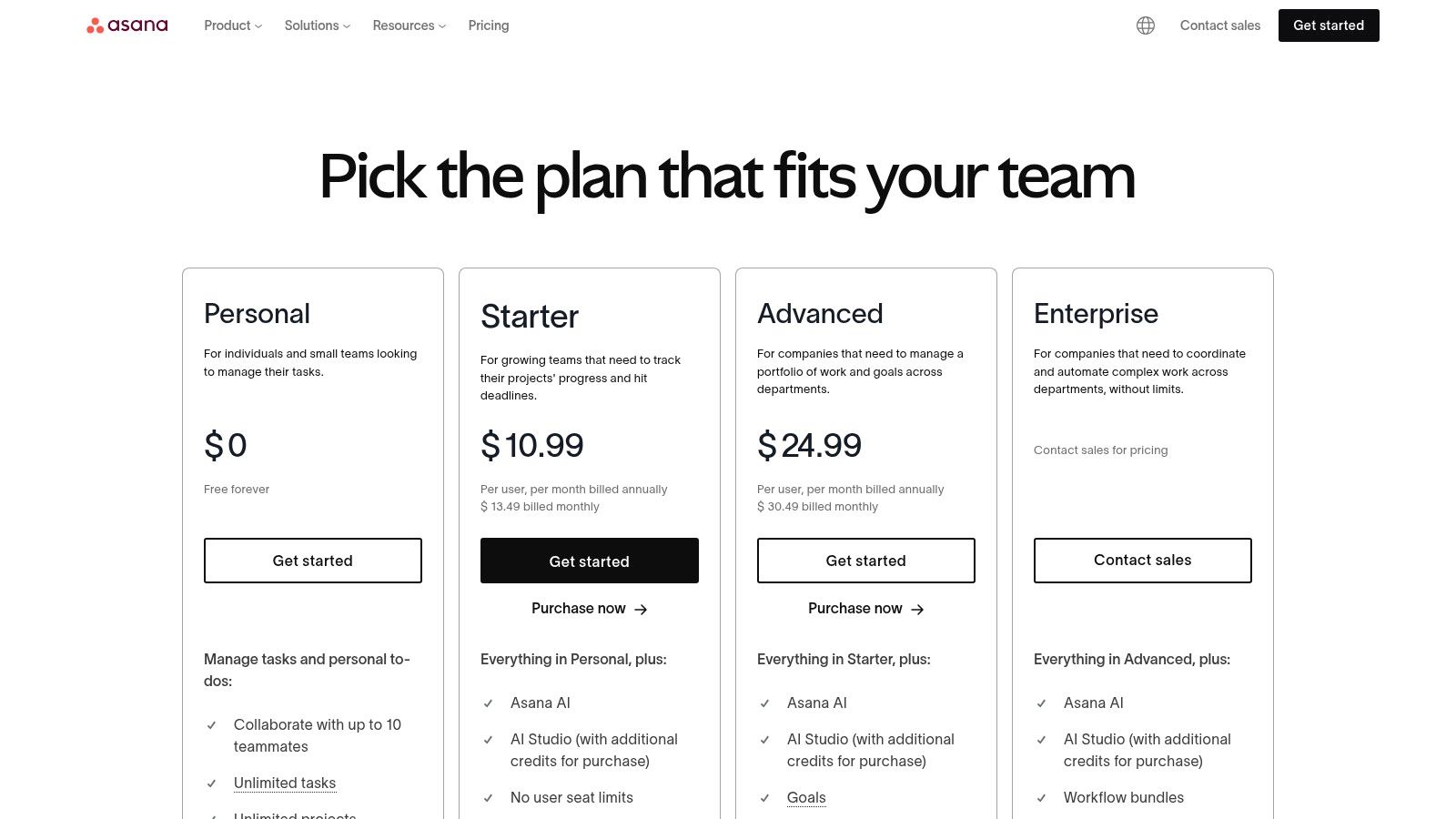
The platform helps teams delegate tasks, set dependencies, and track progress with detailed dashboards. While it might seem like overkill for daily homework, its structured approach is invaluable for long-term academic work where organization is key to success. The free tier is quite generous for individual students or small teams just getting started.
Why It’s a Go-To Resource
Asana excels at bringing clarity to chaos. Instead of juggling tasks in spreadsheets or group chats, it provides a single source of truth for your entire project, from initial brainstorming to final submission. The ability to create templates for recurring projects, like lab reports or presentation prep, saves a ton of time.
Pros: Scales well from solo to complex team projects and offers a generous free tier for basic coursework management.
Cons: Requires more setup compared to simple to-do apps, and its richest features are locked behind paid subscriptions.
Pro Tip: Use the "My Tasks" view as your personal daily planner. It automatically pulls all tasks assigned to you from different projects into one organized list, helping you focus on what's due next.
Website: Asana Pricing
9. Grammarly
For students, producing high-quality written work is non-negotiable, and Grammarly acts as a real-time writing coach. It's more than just a spell checker; it's one of the best productivity apps for students because it analyzes grammar, style, tone, and clarity across essays, emails, and even discussion board posts. The browser extension and app integrations ensure your writing is polished wherever you type.
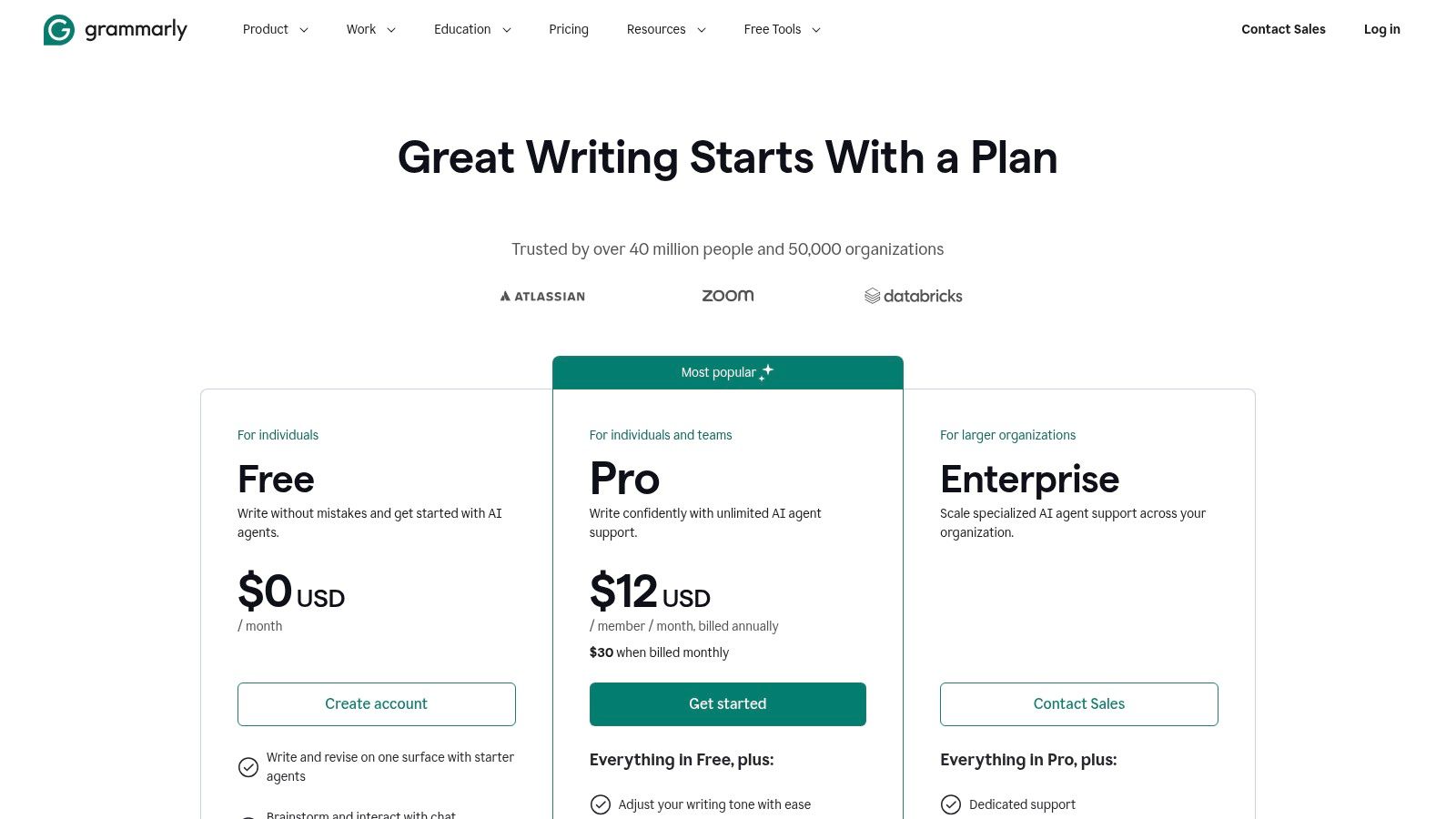
Its suggestions are instant and educational, explaining the "why" behind corrections so you can learn as you go. The premium version unlocks advanced features like plagiarism detection and vocabulary enhancements, which are invaluable for submitting unique and impactful academic assignments. By catching errors before you submit, it saves immense time during the editing process.
Why It’s a Go-To Resource
Grammarly excels by providing a safety net that elevates your writing from good to great. Its seamless integration into platforms like Google Docs and Microsoft Word means it works within your existing workflow, making it an effortless addition to your study toolkit.
Pros: Reduces editing time from draft to final, works seamlessly across major writing platforms, and helps improve writing skills over time.
Cons: Can encourage over-reliance, potentially slowing learning, and advanced features require a Pro subscription.
Pro Tip: Use the tone detector to make sure your emails to professors strike the right balance of formal and friendly. This can also help you see how combining it with tools that help you type faster can significantly boost your output. Find out more about how to improve writing speed.
Website: Grammarly Plans
10. Forest
Forest gamifies focus by turning your study sessions into a virtual tree-growing challenge. It’s one of the best productivity apps for students who struggle with phone distractions. You set a timer, and as long as you stay off your phone, your tree grows. If you leave the app, your tree withers, creating a simple but powerful incentive to stay on task.
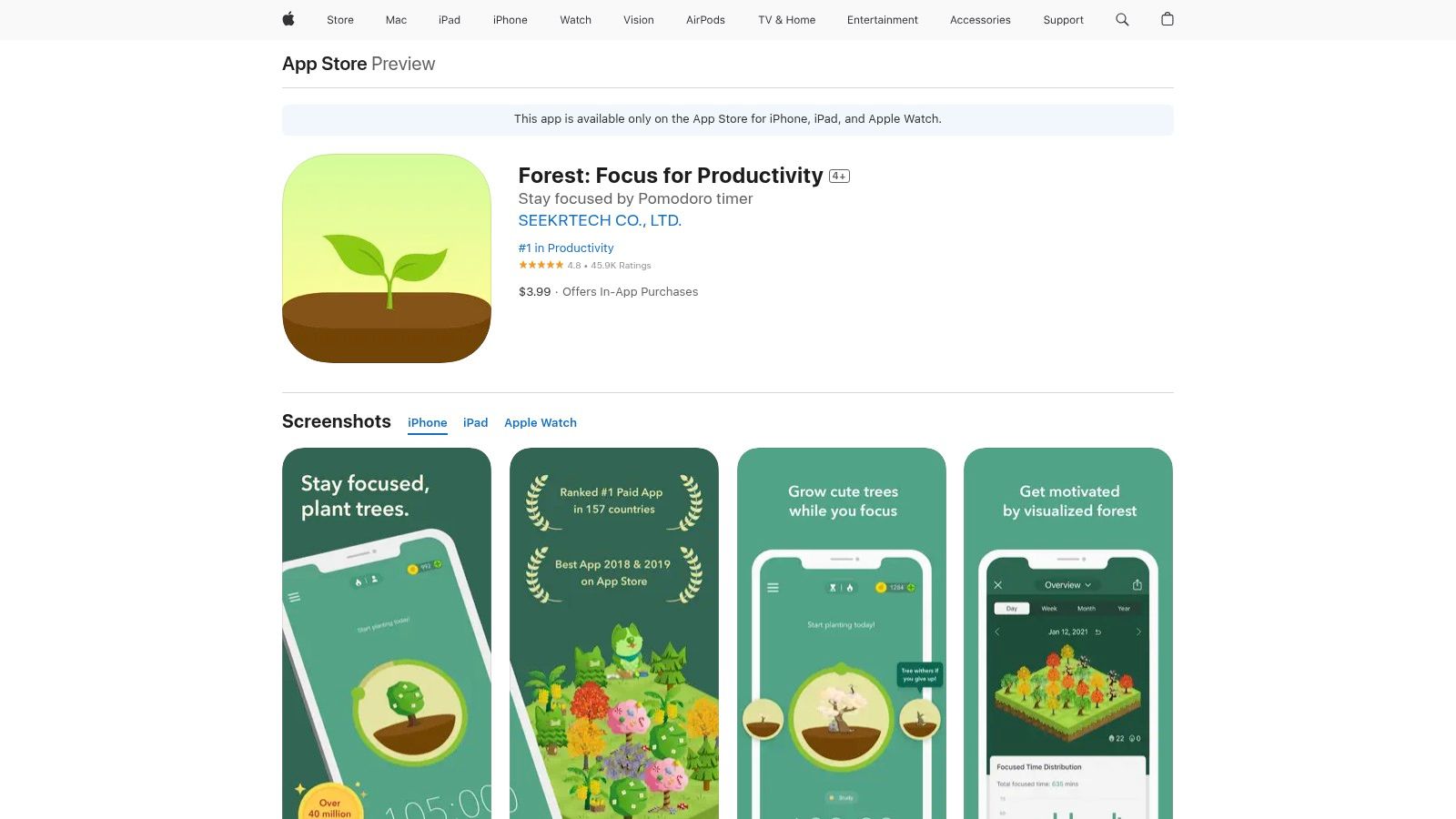
The app combines the Pomodoro Technique with a compelling visual reward system. Over time, you build a digital forest that represents your focused hours. What makes it even more special is its partnership with Trees for the Future, allowing you to spend virtual coins earned in-app to help plant real trees.
Why It’s a Go-To Resource
Forest excels by making the act of avoiding distractions feel rewarding and tangible. Instead of just blocking apps, it provides a positive reinforcement loop that encourages deep work. The ability to whitelist essential apps means you can stay focused without completely disconnecting from important tools.
Pros: Simple and engaging gamified focus aid, with a one-time purchase option on iOS.
Cons: Purchases don’t transfer between iOS and Android, and pricing models can vary regionally on Android.
Pro Tip: Use the "Plant Together" feature to host a virtual study session with friends. Everyone's trees grow together, but if one person gives in to distraction, everyone's tree withers, adding a layer of social accountability.
Website: Forest on the App Store
11. Setapp
For students who find themselves needing multiple specialized tools, Setapp offers a "Netflix for apps" model that can be a game-changer. Instead of buying numerous apps individually, you pay a single monthly subscription for access to a curated library of over 240 premium Mac and iOS applications. This makes it one of the most cost-effective ways to access the best productivity apps for students, especially with their generous education discount.
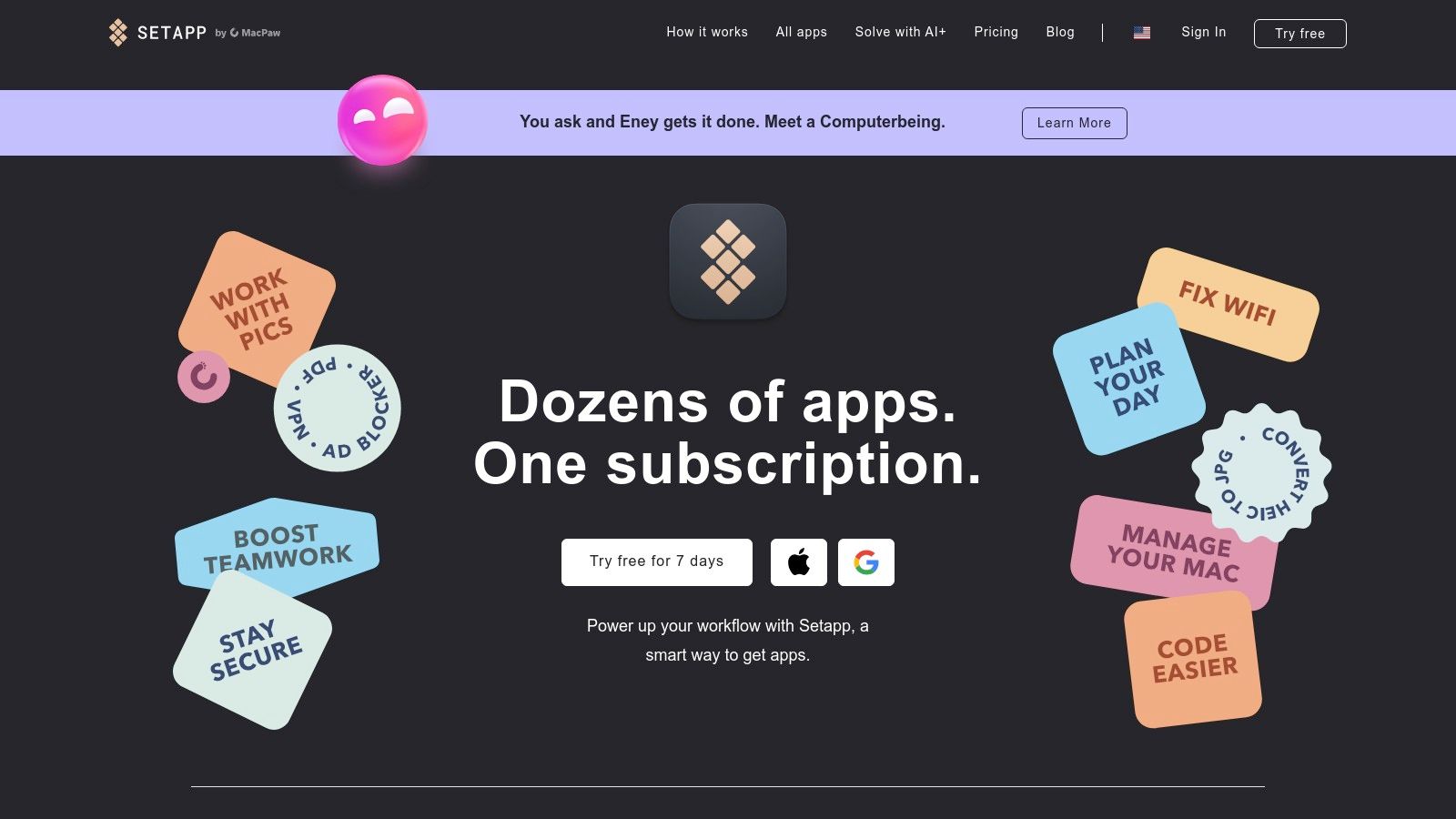
The platform is incredibly user-friendly; you simply browse the catalog, find an app you need for a specific task like mind mapping or PDF editing, and install it with one click. All apps are the full, premium versions with no ads or in-app purchases, which simplifies the entire experience.
Why It’s a Go-To Resource
Setapp's core value is eliminating the financial barrier and decision fatigue of building a software toolkit. The curated collection includes top-tier apps for writing, time management, coding, and design, ensuring you have high-quality tools without the high cost of individual licenses.
Pros: Incredible value with the education discount, access to a wide variety of premium apps, and a curated library that saves you from searching for good tools.
Cons: Only available for Mac and iOS users, and some of the most popular apps in the collection are Mac-only.
Pro Tip: Before subscribing, browse Setapp's full app list on their website to see if it includes at least three or four apps you would otherwise pay for. This will immediately justify the subscription cost.
Website: Setapp for Students
12. Zotero
For any student writing research papers, Zotero is an indispensable tool that takes the pain out of citation management. This free, open-source reference manager helps you collect sources with a single click from your browser, organize them into libraries, and automatically generate citations and bibliographies in your documents. It stands out as one of the best productivity apps for students because it tackles the most tedious part of academic writing.

Its direct integration with Word and Google Docs means you can insert citations as you write, and it supports over 9,000 citation styles, so you're covered for any course requirement. The interface is functional and straightforward, designed for one purpose: making your research process smoother.
Why It’s a Go-To Resource
Zotero excels by offering a powerful, privacy-focused solution at no cost, which is a massive advantage over paid competitors. It’s built for academia by academics, so its features are perfectly aligned with student and researcher needs. If you want to dive deeper into its capabilities, you can read user experiences with Zotero to see how it performs in real-world scenarios.
Pros: Completely free and open-source, massive citation style library, and robust community support.
Cons: The user interface can feel dated, and the free cloud storage for syncing PDFs is limited (paid upgrades are available).
Pro Tip: Install the Zotero Connector browser extension to instantly save articles, books, and other sources to your library with all their metadata intact.
Website: https://www.zotero.org
Top 12 Student Productivity Apps Comparison
Product | Core Features/Characteristics | User Experience/Quality ★ | Value Proposition 💰 | Target Audience 👥 | Unique Selling Points ✨ |
|---|---|---|---|---|---|
🏆 MurmurType | Mac-focused speech-to-text, local & cloud transcription | ★★★★★ Highly accurate, fast | One-time $70 / $6.99 monthly / $20 yearly | Academics, creators, professionals | Local privacy mode, no API keys, full Mac integration |
Apple App Store | Curated Mac/iOS productivity apps | ★★★★ Trusted, easy to use | Free browsing, paid apps vary | iPhone/iPad users, students | Strict vetting, simple refunds |
Google Play | Wide Android productivity app selection | ★★★ Variable app quality | Mostly free, frequent discounts | Android users, students | Huge variety, device compatibility filters |
Microsoft 365 | Full Office suite + AI Copilot, cross-platform | ★★★★ Reliable & familiar | Subscription-based (varies) | Students, professionals | AI-assisted productivity, offline + cloud sync |
Notion | All-in-one workspace with templates & education plans | ★★★★ Highly customizable | Free & paid tiers, education discounts | Students, project managers | Flexible databases, strong community |
Todoist | Task manager with natural language & integrations | ★★★★ Fast, intuitive | Free & premium plans | Students, task-focused users | Natural date parsing, robust filters |
Trello | Visual Kanban boards for team projects | ★★★ Simple & team-friendly | Free & paid tiers | Students, teams | Powerful integrations, easy collaboration |
Asana | Structured workload management with AI & automation | ★★★★ Scalable & feature-rich | Free basic, paid advanced | Teams, large projects | AI features, extensive reporting |
Grammarly | Real-time writing assistance + plagiarism checks | ★★★★ Improves clarity & tone | Free & Pro subscriptions | Writers, students, professionals | Cross-platform, style & plagiarism detection |
Forest | Gamified focus timer & phone distraction blocker | ★★★ Engaging & motivational | One-time purchase (iOS), subscriptions (Android) | Students wanting focus | Real tree planting, streak tracking |
Setapp | Mac/iOS app subscription bundle with education discounts | ★★★★ Convenient all-in-one | Subscription-based | Students using multiple Mac apps | Large curated app library |
Zotero | Free open-source reference manager | ★★★★ Robust & privacy-friendly | Free, paid cloud storage upgrades | Academics, researchers | 9,000+ citation styles, Word/Google Docs plugins |
Build Your Perfect Study Stack and Get More Done
We've explored a powerful lineup of tools, from comprehensive platforms like Notion and Microsoft 365 to specialized champions like MurmurType and Zotero. The journey to find the best productivity apps for students isn't about downloading every single one. Instead, it's about thoughtfully crafting a personalized digital toolkit, your very own "study stack," that aligns with your unique workflow and academic demands.
The sheer number of options can feel overwhelming, but the core principle is simple: start with your biggest pain point. Are you drowning in disorganized research notes? A tool like Zotero or the web clipper in Notion could be a game-changer. Do you struggle to stay focused during long study sessions? An app like Forest provides a clear, motivating solution.
How to Choose Your Starting Lineup
Don't try to implement ten new apps overnight. That's a surefire recipe for digital burnout. A more effective approach is to select just one or two apps to integrate into your routine.
For the Ultimate Organizer: If your goal is to create a central hub for everything from class notes to project plans, start with Notion. Its flexibility is unmatched, allowing you to build the exact system you need.
For the Task-Oriented Student: If your main challenge is keeping track of deadlines and daily assignments, Todoist is your best bet. Its simple, powerful interface helps you capture and organize tasks effortlessly.
For the Aspiring Writer: If writing papers and essays is your biggest hurdle, focus on integrating Grammarly for polishing your prose and a specialized tool like MurmurType to streamline the drafting and citation process.
The Real Goal: Less Tool Management, More Learning
Remember, the ultimate purpose of any productivity app is to disappear into the background. Your tools should serve you, not the other way around. If you find yourself spending more time tinkering with settings and organizing your organization system than actually studying, it's time to simplify.
The perfect app is the one you consistently use because it makes your life easier. It reduces friction between you and your work. As you experiment, pay attention to which tools feel intuitive and which feel like a chore. The goal isn't to build the most complex system; it's to build the most effective one for you.
This list of the best productivity apps for students is your starting point. Now, it’s your turn to experiment, combine, and conquer. Pick your first tool, commit to using it for a week, and see the difference it makes. You have the power to design a more focused, organized, and successful academic life. Go build your ideal study stack and make this your most productive semester ever.